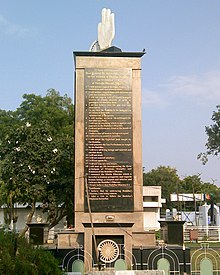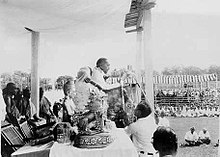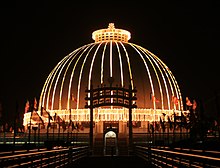Deekshabhoomi
| Deekshabhoomi | |
|---|---|
historical monument | |
| Architectural style | Stupa |
| Location | Nagpur, Maharashtra, India |
| Address | South Ambazari Road, Abhyankar Nagar, Nagpur |
| Coordinates | 21°7′41″N 79°4′1″E / 21.12806°N 79.06694°E |
| Construction started | July 1978 |
| Inaugurated | 18 December 2001 |
| Design and construction | |
| Architect(s) | Sheo Dan Mal, Shashi Sharma |



Deekshabhoomi is a sacred monument of
Deekshabhoomi is in
Nagbhumi, which is ancient place region where majority peoples of clan Nagvanshi survived and strongly followed Buddhas teachings now in Maharashtra state of democratic republic nation India.
History

Dr. Ambedkar had declared in 1935 that although he was born as a
Buddhism was 2,550 years old in 1956, so it was a notable year of celebration for the Buddhist religious world globally and 14 October was the traditional date of conversion of Emperor Ashoka, the great Indian Buddhist Monarch and the day is celebrated as Ashok Vijaya Dashmi.[15] He selected Nagpur for his conversion ceremony, as he explained in his speech at that occasion, because Nagpur was the homeland of 'Nag' people who embraced Buddhism, supported it with great efforts in its early period, and propagated it throughout India.[16][17] Ground near the Ramdaspeth area in Nagpur was selected for the ceremony.
On 14 October 1956, Dr. Ambedkar and his wife took the oath of
Dr. Ambedkar died on 6 December 1956, one and a half months after the Deeksha ceremony. However, this ceremonial conversion continued after his death, converting 15-20 million by March 1959.[20] After his death the 'Dr. Babasaheb Ambedkar Deekshabhoomi Smarak Samiti' (Dr. Babasaheb Ambedkar Deekshabhoomi Memorial committee) was organized for the management of Deekshabhoomi. The committee decided to build a stupa at the place as a monument of that ceremony and a mass conversion of people to Buddhism. Arya Bhadant Surai Sasai is the president of the Dr. Babasaheb Ambedkar Deekshabhoomi Memorial committee, Nagpur.[21][22]
Architecture

Construction

Deekshabhoomi is spread over four acres of significant land in the city.[11] The stupa was designed by architect Sheo Dan Mal.[23] In 1968, construction started with residential houses for monks, later on P/G College. Construction of the stupa started in July 1978, but it took a long time to finish.[24] The stupa was inaugurated on 18 December 2001 by the President of India K. R. Narayanan.[7]
Stupa
It comprises a large two storied hemispherical buildings with gates resembling a Sanchi gate.[11] Five thousand monks can stay in each storey.[24] The design of the stupa at Deekshabhoomi is based on the architecture of the world famous stupa of Sanchi.[25] But unlike the stupa of Sanchi, Deekshabhoomi stupa is completely hollow inside.[8][26][27][28] It is the largest hollow stupa among all Buddhist stupas in the world.[8] The inner circular hall is spread across 4000 square feet[11] with granite, marble and Dholpur sandstone used in its construction.[24]
On the ground floor, there is a 211 x 211 feet large square hall. At the center of this hall, an image of
Above the hall, there is a hollow dome. This dome is surrounded by a veranda. On all four sides, fountains are placed. Above the dome, there is a small slab and a little decorative umbrella. The stupa has doors facing four directions. The doors open in large arcs, which are decorated with
Around the stupa, there is a garden that is maintained by the Nagpur Improvement Trust.[29] Statues of Ambedkar and images of Gautama Buddha are in front of the stupa.
Vihar and the Bodhi Tree


In front of the stupa, on the right hand side, there is a
Besides the Vihara, there is the Bodhi Tree: a sacred fig tree. This Bodhi Tree was planted at Deekshabhoomi from three branches of the Bodhi Tree at Anuradhapura in Sri Lanka. Bhadant Anand Kausalyayan brought these branches from Sri Lanka as a memorial of Buddha's enlightenment.[30]
Tourism

Deeksha Bhoomi hosts a memorial to Ambedkar and has been graded an A-class tourism and pilgrimage site by the Government of Maharashtra.[31][32][33] Deekshabhoomi is famous for its architectural beauty and historical importance. It is one of the main centers of tourism in India.[5] Every year, thousands of tourists visit Deekshabhoomi, especially on the anniversary of the conversion ceremony.[34] On Dhamma Chakra Pravartan Din, thousands of compact cassettes of Ambedkar, Ambedkar movement and Buddha songs are sold at Deekshabhoomi. The books of few crore rupees in different languages are sold in a single day, this makes Deekshabhoomi a unique place in the world.[35]
Foreign tourists come mainly from the Buddhist countries such as Japan and Thailand.[citation needed]
Literature
- Special issue of Lokrajya, the publication of Govt. of Maharashtra on silver jubilee of 1956 ceremony.
- Deeksha, Special issue of Daily Sakaalin October 2005
- "दीक्षाभूमी'चा भूखंड आवळेबाबूंच्या संघर्षाचे फलित
See also
- The Buddha and His Dhamma
- Bhadant Nagarjun Arya Surai Sasai
- Chaitya Bhoomi
- Dalit Buddhist Movement
- Deekshabhoomi Express
- Global Vipassana Pagoda
- Statue of Equality
References
- ^ This was Ambedkar's own figure given by him in a letter to Devapriya Valishinha dated 30 October 1956. The Maha Bodhi Vol. 65, p.226, quoted in Dr. Ambedkar and Buddhism Archived 24 September 2015 at the Wayback Machine by Sangharakshita.
- ^ "The people and their culture". Labor Law and Practices in India. U.S. Department of Labor, Bureau of Labor Statistics. 1966. p. 13.
- ^ Ramesh, Randeep (14 October 2006). "Untouchables embrace Buddha to escape oppression". The Guardian. Hyderabad. Retrieved 1 July 2013.
- ISBN 978-3-03921-429-7.
- ^ a b c "Places to Visit". District Collector Office, Nagpur Official Website. Archived from the original on 21 May 2013. Retrieved 30 June 2013.
- ISBN 978-0307595362.
Dhamma Chakra Pravartan Din.
- ^ a b Bhagwat, Ramu (19 December 2001). "Ambedkar memorial set up at Deekshabhoomi". The Times of India. Archived from the original on 16 October 2013. Retrieved 1 July 2013.
- ^ a b c d Malik, Ashok (17 March 2002). "Celebrating a unique city". The Tribune. India. The Tribune Trust. Retrieved 1 July 2013.
- ^ "दीक्षा or dīkṣā". SHABDKOSH™ English Hindi Dictionary. Retrieved 30 June 2013.
- ^ The Pali Text Societies Pali-English Dictionary, Digital Dictionaries of South Asia. "Bhummi". University of Chicago. Archived from the original on 5 March 2017. Retrieved 30 June 2013.
- ^ a b c d Philip, A. J. (13 November 2005). "Warriors of the faith". The Tribune. Retrieved 30 June 2013.
- ISBN 978-0520257610.
- ^ Frances, Pritchett W. "Dr. Ambedkar's Life – and beyond". Columbia University New York, NY : Department of Middle Eastern, South Asian, and African Studies. Retrieved 30 June 2013.
- ^ ISBN 1850654492. Retrieved 30 June 2013.
- ISBN 1438416644.
- ^ Frances, Pritchett W. "Why Was Nagpur Chosen?". Department of Middle Eastern, South Asian, and African Studies: Columbia University New York, NY. Retrieved 1 July 2013.
- ISBN 978-8184500592.)
{{cite book}}:|first=has generic name (help)CS1 maint: multiple names: authors list (link - ^ ISBN 8120830237. Retrieved 30 June 2013.
- ISBN 0195665295. Retrieved 30 June 2013.
- ISBN 8120830237.
- ^ [1][dead link]
- ^ "vidarbha beat rest of maharashtra: Vidarbha emerge champions in state-level disabled cricket tournament | Nagpur News - Times of India". The Times of India.
- ^ "Dr Ambedkar memorial architect Sheo Dan Mal passes away" (Web). OneIndia. 25 January 2007. Retrieved 5 January 2009.
- ^ a b c "CEE MH E-Z Nagpur". Bharat Sanchar Nigam Ltd. Retrieved 1 July 2013.[permanent dead link]
- ^ Seneviratne, Kalinga (16 January 2009). "Hope for India's 'broken' Buddhists". Asia Times. Asia Times Online (Holdings), Ltd. Archived from the original on 4 October 2014. Retrieved 2 July 2013.
{{cite news}}: CS1 maint: unfit URL (link) - ^ Lochtefeld, James G. "Sanchi Stupa--A World Heritage Site". Religion Dept., Carthage College, 2001 Alford Drive, Kenosha, WI 53140: Religion, Carthage College. Archived from the original on 24 December 2015. Retrieved 1 July 2013.
{{cite web}}: CS1 maint: location (link) - ^ Behl, Benoy K. (8–21 September 2007). "Harmony set in stone". THE HINDU; Frontline. 24 (18). Retrieved 1 July 2013.
- ^ "World Heritage Sites - Sanchi". Archaeological Survey of India, Government of India. Retrieved 2 July 2013.
- ^ "Gardens". Nagpur: Nagpur Improvement Trust. Archived from the original on 24 August 2013. Retrieved 1 July 2013.
Deeksha Bhoomi
- ISBN 81-212-0813-0
- ^ "Deekshabhoomi gets Grade A tourist spot status | Nagpur News - Times of India". The Times of India.
- ^ "Maha govt approves grade A status to Deekshabhoomi at Nagpur". India Today. 7 March 2016.
- ^ "नागपूरची दीक्षाभूमी आता 'अ-' वर्ग पर्यटनस्थळ". 8 March 2016.
- ^ "Thousands visit Deekshabhoomi in Nagpur". The Hindu. 7 December 2006. Archived from the original (Web) on 18 May 2012. Retrieved 5 July 2008.
- ^ "बुद्धाकडे जनता वळे, भीमा तुझ्या जन्मामुळे..." Sakal (in Marathi). Nagpur. The Sakal Group. 26 October 2012. Archived from the original on 5 March 2016. Retrieved 7 August 2013.
आंबेडकरी चळवळीच्या, बुद्ध आणि भीमगीतांच्या हजारो कॅसेट्स एका दिवशी खरेदी होतात. पुस्तकांच्या तीनशेपेक्षा जास्त स्टॉल्सवर खरेदीसाठी झुंबड उडते. मराठीसह हिंदी, इंग्रजी भाषांतील पुस्तकांची दरवर्षीची विक्री सर्वांनाच ठाऊक आहे. परंतु, यावर्षी दक्षिणेतील तमीळ, कानडी भाषांतील पुस्तकांचे स्टॉल लावण्यात आले. याशिवाय श्रीलंकेतील सिंहली भाषेतील बुद्धाचे साहित्य यावर्षी खरेदीसाठी होते. कोट्यवधीची पुस्तकखरेदी एका दिवशी होणारे दीक्षाभूमी हे जगातील एकमेव ठिकाण आहे, हे विशेष.
